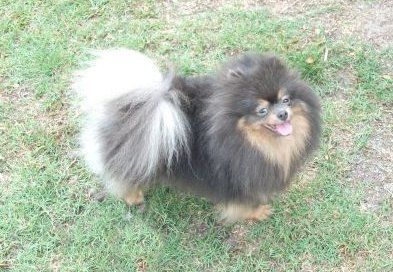Pomeranian - Colour Genetics
Colour Genetics in the breed...
Since publishing this article back in 2009/2010 Orivet now offers full genetic testing and provies you with results (A bonus to us breeders). Link to their site: https://www.orivet.com
Most sables also have hairs which are all black mixed in the coat. Some animals are so dark as to have only a small amount of tan next to the skin, others have only a few black tipped hairs on the dorsal line of the back or a few black tipped hairs on the dorsal side of the tail.
The gene ch (chinchilla) reduces red-yellow pigment but leaves black in the coat untouched. This is the gene, when fully extended, which produces the most desirable wolf-sable by virtually eliminating yellow from the coat of a sable dog.
This same gene (c/ch) is involved in the production of the sooty cream sable. The wolf-sable colour is not the result of or dependent on genes which produce blue, although it might be possible to breed a blue-sable. In this event, the tips of the hairs would be blue instead of black. Nose, eye rims, lips and pads would also be blue instead of black as in the wolf-sable.
The Maltese blue colour found in Pomeranians is the result of the action of a pair of recessive genes (dd). The pigment is black, but the clumping arrangement is different and the granules are both smaller and fewer in number that in the hair of a black dog. The infraction of light on the hair shaft leaves the illusion of blue. Colour ranges from very dark slate (almost black) to Maltese blue found in the Russian Blue cat. Puppies are born blue and rather a lighter shade than they will be as adults.
This is not the same blue which results from the greying gene (G) as in the Kerry Blue Terrier and the Poodle. These animals are born black and progressively turn grey as they mature. People who are not familiar with the blue of the Pomeranian often refuse to believe this is the colour referred to in the standard because they are accustomed to seeing the lighter silvers of the Poodle and expect the Pom to be the same. However, the gene for greying (G) is not present in the Pom, so the colour remains as it was at birth, a Maltese blue.
I have been fortunate to have bred a blue and tan Pomeranian, the first to gain it's Australian Champion title. This bitch is by my Multi-R/Up Best in Show Champion dog Cupidtown Gold N Chance and from Ms Aprile's bitch Champion Orionstars Iron Maiden.
Ch, Cupidtown Gold N Chance lineage contains Heartlands Blue Pagan (IMP USA) who is registered as being BLUE.
Pictured below..."Ch. Orionstarts Iron Maiden" - Blue and Tan

Contact Details
Taryn Jones
Rockhampton, Central Queensland, 4702
Facebook: https://www.facebook.com/pages/Tooshay-Pomeranians/503745683040651
Tooshay Poms [email protected]
